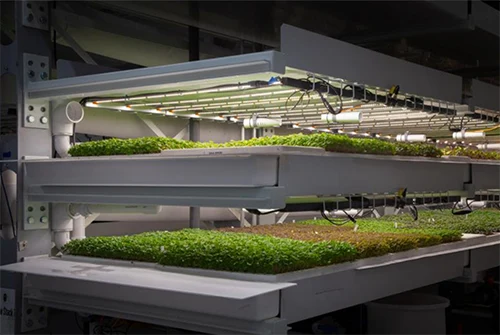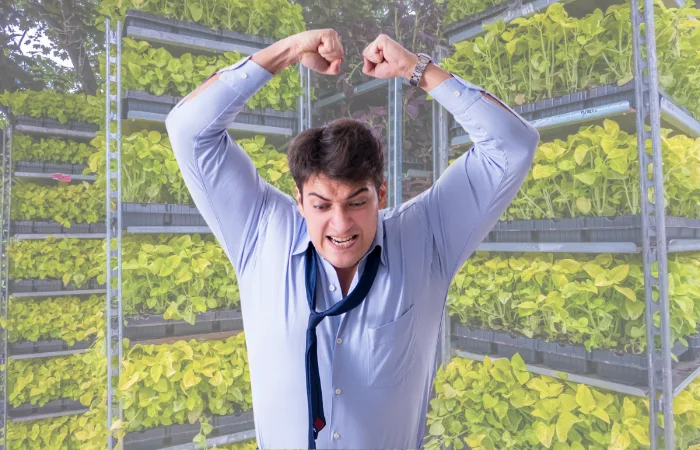Vertical farming, once heralded as a revolution in agriculture, is now facing a harsh examination. Amidst the technological advancements and environmental promises, many vertical farming companies have stumbled and fallen. This trend, unfortunately, raises an important question: What pitfalls are causing these innovative ventures to fail? Do most of these closures and bankruptcies have anything in common?
In this article, we delve deep into the factors leading to the downfall of vertical farming startups. Our investigation isn’t just a surface scan; it’s an in-depth exploration backed by real data, financials, and firsthand accounts. We aim to provide a comprehensive resource for those in the industry seeking to learn from past mistakes and pave a more successful path forward.
- The critical financial and operational missteps leading to vertical farm failures.
- Detailed case studies and data analysis.
- Valuable insights and advice from industry experts and those directly involved.
Join us as we unravel the complexities behind the failures of vertical farming, aiming to turn hindsight into foresight for future endeavors.
Mistake 1: Overlooking the Real Costs
In the world of vertical farming, getting the math wrong can be disastrous. It’s like setting up a lemonade stand as a kid and forgetting to factor in the cost of lemons and sugar. Many vertical farms have jumped into the market, attracted by the idea of high-tech agriculture, only to find that their expenses far outweigh their earnings.
Consider the energy costs. Vertical farms rely heavily on artificial lighting and climate control systems. It’s not just about planting seeds and watching them grow. These farms have to mimic the sun and control the weather inside a building! This can lead to sky-high electricity bills, something that many startups fail to anticipate adequately.
Then there’s the issue of scale. In a traditional farm, expanding usually means planting more fields. But in vertical farming, scaling up involves complex and costly infrastructure like additional grow racks, lighting systems, and climate control units. The initial investment can be much higher than expected, and the returns might not always keep pace.
Even well-funded startups like Square Roots, helmed by Elon’s brother, Kimbal Musk, wasn’t immune to this issue.
Experts in the field agree that a realistic approach is vital. After all, it’s not just about growing up; it’s about growing smart. Understanding the full spectrum of costs, from seeds to electricity to labor, is essential. You can’t just focus on the plants; you have to look at the whole garden.
Mistake 2: Misjudging Return on Investment
You gotta understand and embrace real ROI! Many startups, dazzled by the potential of vertical farming, leaped into the industry without a solid grasp of the financial reality. The miscalculation of costs versus revenue potential has led to quick downfalls of quite a few players and lost a lot of investors a lot of money in the process.
Let’s look at FarmedHere. Once the largest indoor vertical farm in the United States, the vertical farm upstart was rolling in VC funding and was nearly drowning in media attention, but FarmedHere shutdown operations in 2017. The company cited the main reason as the high operational costs, which included energy-intensive lighting systems and climate control technologies, outweighing their revenue. Simply put, the founders didn’t have realistic financial planning in place.
Industry experts stress the significance of a thorough ROI analysis. John Smith, an agricultural finance specialist, comments, “Vertical farming holds great promise, but it is essential to enter the field with eyes wide open to the financial realities. A detailed and realistic analysis of investment, ongoing expenses, and market potential is crucial for long-term viability.”

Mistake 3: Underestimating the Market’s Needs
Just like a new restaurant might struggle if it doesn’t understand its customers’ tastes, vertical farms can falter by misreading the market. It’s not enough to grow food; you must grow what people actually want to buy. Many vertical farming startups have focused more on the technology and less on what the market demands, leading to a mismatch in supply and demand.
Take the example of LocalGrown, a vertical farming startup that invested heavily in growing exotic herbs. While the idea seemed innovative, they soon realized that the demand for these herbs was limited in their local market. The result? Shelves full of unsold produce.
It’s like opening a sushi restaurant in a small town where everyone loves burgers – the product might be fantastic, but if it’s not what people want, it won’t sell. As Sarah Johnson, a food industry analyst, puts it, “Innovative farming technology is great, but at the end of the day, it’s all about what the customer wants. Understanding the local market’s preferences and dietary habits is crucial for any agricultural venture.”
Mistake 4: Neglecting Strong Business Planning
Imagine setting out on a road trip without a map or GPS. That’s akin to starting a vertical farm without a solid business plan. Some vertical farming ventures dive into the field with innovative ideas, but lack a clear roadmap for growth and sustainability. A strong business plan is like a compass; it helps navigate through the ups and downs of the market and keeps the business on track.
A key example is Fifth Season, a vertical farming startup with groundbreaking technology for growing leafy greens. Their tech was top-notch, but they lacked a clear plan for scaling up, managing costs, and reaching customers effectively. As the business grew, they faced logistical nightmares and marketing mishaps, eventually leading to their closure.
Experts in business development stress the importance of planning. As Tom Harrison, a veteran business strategist, notes, “Innovative technology isn’t a substitute for a solid business strategy. A comprehensive plan that covers everything from production to marketing to scalability is not just helpful; it’s essential for survival in this competitive field.”
Mistake 5: Overlooking Labor and Expertise
Running a vertical farm isn’t just about having green thumbs; it requires a blend of diverse skills and expertise. It’s similar to a tech startup assuming they can get by with just programmers, only to realize they need sales, marketing, and customer support teams too. Many vertical farms have underestimated the need for a skilled workforce that understands both agriculture and the specific challenges of vertical farming.
This brings us to the vertical farming darling AppHarvest, which filed for bankruptcy on July 23, a vertical farm that began with a team of enthusiastic engineers and botanists. While they had the technical and agricultural knowledge, they lacked experience in supply chain management and marketing, which are crucial for getting products from farm to table. This gap in their team’s expertise led to operational inefficiencies and a struggle to connect with the market effectively.
The importance of a well-rounded team is echoed by industry leaders. As noted by Anna Liu, an agricultural business consultant, “Vertical farming isn’t just farming; it’s a complex interplay of technology, biology, and business. Having a team that collectively covers these areas is not a luxury, it’s a necessity for success.”

Mistake 6: Failing to Adapt to Changing Technology
In a field as dynamic as vertical farming, resting on your laurels can be the kiss of death. It’s akin to using an old flip phone in a smartphone world. Technology in vertical farming evolves rapidly, and failing to keep up can quickly render a farm obsolete. Many startups have struggled because they invested heavily in technology that soon became outdated, unable to compete with more efficient, newer systems.
Consider the example of Upward Farms, a vertical farm that started with a bang, using what was then state-of-the-art, but expensive, aquaponic technology. However, as newer, more efficient aeroponic systems came onto the scene, they found themselves unable to compete. Their yields were lower, and their costs higher. They had locked themselves into an outdated system and couldn’t pivot quickly enough to stay relevant.
This predicament is not uncommon in tech-heavy industries. As technology evolves, so must businesses. Jake Roberts, a tech analyst specializing in agricultural technologies, advises, “In a field like vertical farming, where technology is a core component, staying updated isn’t just about growth; it’s about survival. Regularly assessing and upgrading your technology can make the difference between thriving and closing shop.”

Mistake 7: Ignoring Customer Engagement and Feedback
Operating a vertical farm without engaging with customers is like sailing a boat without a compass. You might move forward, but you won’t necessarily be headed in the right direction. Many vertical farms focus intensely on the technical and agricultural aspects of their operations, neglecting the crucial element of customer interaction. Without understanding customer needs and feedback, these farms often miss out on valuable insights that could drive their success.
For instance, Agricool made significant headway in urban agriculture with its state-of-the-art vertical farm. However, they operated in a bubble, rarely stepping out to engage with their customer base. As a result, they were slow to realize changing consumer preferences for organic produce, which competitors quickly capitalized on. This oversight led to a gradual decline in their market share.
Engaging with customers is not just about selling produce; it’s about building relationships and trust. Emily Parker, a veteran in customer relations for agribusinesses, emphasizes this point: “The best technology in the world can’t replace the insights you gain from direct customer interaction. Understanding what your customers want, their concerns, and their feedback is vital. It’s the fuel that keeps your business growing in the right direction.”
Mistake 8: Underestimating the Importance of Marketing
Imagine having a fantastic product that nobody knows about. This is a reality for many vertical farms that underestimate the power of marketing. Today, it’s not just about what you grow, but how you tell your story. And, as any marketer will tell you, stories are what sells!
Many vertical farming businesses have excellent produce, but struggle to gain traction because they haven’t invested enough in getting the word out. No marketing means no one knows you exist.
A case in point is Iron Ox, a vertical farm with an impressive array of organic vegetables. While their product quality was top-notch, and their technology was even more impressive, their marketing efforts were minimal. They relied solely on word-of-mouth, an inconsistent Facebook page, and some local advertising. Needless to say, they missed out on the vast potential of digital marketing and social media outreach. This lack of visibility meant slower growth and limited market penetration compared to their more marketing-savvy competitors.
Marketing isn’t just an add-on; it’s an essential part of any business strategy. As digital marketing expert Michael Brown puts it, “In the digital age, having a great product is only half the battle. The other half is making sure people know about it. Effective marketing can elevate a vertical farm from a local player to a recognized brand.”

Mistake 9: Overlooking Sustainability and Environmental Impact
In the pursuit of profit and productivity, some vertical farms have overlooked a critical aspect: sustainability. It’s like running a marathon without pacing yourself – you may lead at first, but you won’t last long. Vertical farming, at its core, promises a more sustainable way of producing food. However, if not managed properly, it can end up consuming excessive resources, negating its environmental benefits.
For example, Kalera, a vertical farm focused on rapid expansion (and funding to burn), found itself facing backlash for its high water and energy usage. Their initial success was overshadowed by concerns over their environmental footprint, leading to a loss of customer trust and support. This oversight in sustainability not only harmed their reputation but also went against the very principles of vertical farming.
Sustainability isn’t just a buzzword; it’s a responsibility and a business strategy.
Environmental expert Dr. Lisa Nguyen remarks, “Vertical farming has the potential to revolutionize our food systems, but it must be done responsibly. Balancing productivity with sustainability is key. Farms that achieve this balance not only contribute positively to the environment but also build stronger, more loyal customer bases.”
Conclusion
More To Discover
- Supercharging Seeds? How Rainstick’s ‘Electrical Storm’ Technology Is Electrifying Crop Growth
- Cryptocurrency and the Environment: In-Depth Study Examines The Hidden Costs of a Digital Gold Rush
- Grain Husk Packaging: The Future Alternative to Plastic Styrofoam in Your Next Delivery
- What is Bioponics? Discussing The Organic Closed-Loop Cultivation System That Uses No Soil
Our journey through the missteps of vertical farming ventures reveals a landscape filled with both challenges and opportunities. Like any pioneering industry, vertical farming faces its share of growing pains. From underestimating costs to overlooking market needs, from weak business planning to neglecting sustainability, these mistakes offer valuable lessons.
- Misjudging ROI and operational costs can quickly turn a promising venture into a financial burden.
- Understanding and adapting to market needs is crucial; it’s not just about growing food, but growing what people want.
- Comprehensive business planning, team expertise, and embracing technological advancements are vital for staying competitive.
- Customer engagement and effective marketing are indispensable for growth and market penetration.
- Lastly, maintaining a focus on sustainability is key to honoring the ethos of vertical farming and ensuring long-term viability.
For anyone venturing into this innovative field, these insights aren’t just warnings but guiding lights towards a more sustainable, efficient, and successful future in vertical farming.






















